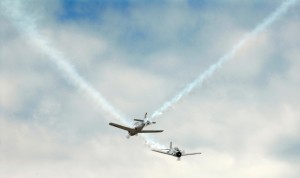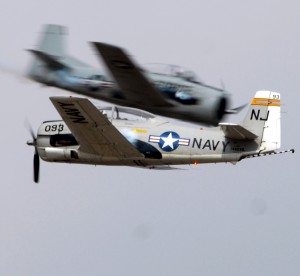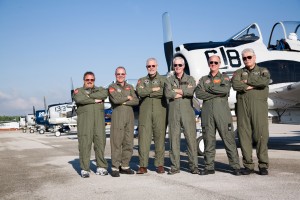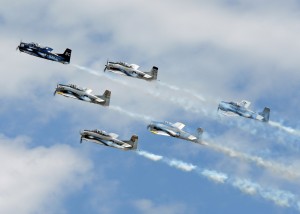
The Trojan Horsemen are captured in the brief moment of completing their famous “heart maneuver.” On the left is the Navy aircraft piloted by Jack “Skids” Mitchard, who duets with Dr. Ralph “Skydoc” Glasser in the Air Force version, right.
By Clayton Moore
Unlike the conquering Greek heroes of the myth from which they draw their name, the pilots of the Trojan Horsemen warbird demonstration team don’t sneak up on anyone. In fact, it would be next to impossible, with half a dozen T-28 military planes roaring out of the sun, flying much as they did in conflicts from the Congo to Vietnam.
Today, the mission of the Trojan Horsemen is more humanitarian than that of their namesake. The flying team assembles each season to perform an incredibly adept formation aerobatic act at air shows across America. They dedicate their performances to the men and women who’ve served in all of the country’s military services, and their patriotic performance reflects the team’s own deep loyalty to the United States.
“Our performances are first and foremost a tribute to the armed forces,” said Jim Stitt, the team’s managing member and its number 4 wingman. “We’re all warbird owners and, as such, feel it’s important to preserve that part of our heritage. We feel it’s of vital importance to maintain these aircraft so that future generations can appreciate them. We’re also duty bound to honor our veterans, so people are reminded of the tremendous price that others have paid and we can enjoy the freedoms we have today.”
Shopping for warbirds
Stitt has been flying for more than 25 years and once served as president of the Cincinnati Warbirds EAA Squadron 18 based at Lunken Airport (LUK). He owns his own broadcast engineering business, but for many years, his passion has been for warbirds and formation flying. His multiple ratings include a private license, commercial license, instructor rating and certifications in formation flying and aerobatics.
“I’ve always loved aviation,” Stitt said. “I took my first ride back in the 1960s and got hooked. I applied to the Air Force and the Navy during Vietnam, but couldn’t meet the criteria, so I did my training in the civilian world. Getting the next rating was just another reason to go flying, so I continued to gain proficiency and knowledge simply for the sake of knowledge.”
He’d been flying the T-34 Mentor training aircraft derived from the Beechcraft Model 35 Bonanza, but a structural safety issue grounded that fleet in 2004. Stitt began brainstorming a new air show concept, and started pondering airplanes to use in a potential act, finally settling on the T-28 Trojan.
“The issue with the T-34s quickly put an end to doing anything aerobatic with those aircraft,” Stitt recalled. “I was looking for another airplane that would attract everyone’s attention. If you look at the exit interviews from the various shows, they indicate that what audiences and producers like best, after jet teams like the Blue Angels, are warbirds and team performances. I thought a warbird team would combine the best of both worlds.”
Several teams are using T-6 Texans as formation aircraft, and another act called Herb & Ditto uses the T-28 for solo smoke ring aerobatics, but Stitt’s research revealed no other act like the one he envisioned. He also believed in the aircraft. Its robust 1,425-hp Curtiss-Wright 1820-86 engine helps it achieve a top speed of 343 knots and a climb rate of more than 3,000 feet per minute. In fact, some say the T-28 can out-turn and out-climb a P-51 Mustang.

In a daring “heart cross” maneuver performed at the 2007 EAA AirVenture Oshkosh, Trojan Horseman Jack “Skids” Mitchard, in the Navy plane in the foreground, appears breathlessly close to Dr. Ralph “Skydoc” Glasser in the blurred Air Force T-28.
“It’s a fantastic air show aircraft for a lot of reasons,” Stitt said. “It’s fast and it’s loud, because it has this growling radial engine. It’s a big airplane, so it has a commanding presence on the ramp. It’s a lot of airplane for the money, which is one of the reasons I picked it.”
Fixing up a high-performance military aircraft is no small task, and each member of the Trojan Horsemen is intimately familiar with the inner workings of their T-28.
“There are people who put more than one million dollars into restoring one of these aircraft from the ground up,” Stitt said. “Most people simply fix the maintenance issues and then continue to restore it. But it’s still one-quarter to one-half million just to buy the airplane. Because of its complexity, you have to continue to maintain it, and that’s where the operating costs are relatively high. Aviation is a good way to spend all the money you make.”
In flight, Stitt says, the complex flight systems and considerable power of the aircraft can prove challenging, despite a relatively simple operating platform. A friend of his described the aircraft as “flying like a Cherokee with a 1,400-hp engine.”
“Once you learn the systems on the aircraft, the stick-and-rudder flying is quite easy,” Stitt said. “It has a lot of dihedral, so it’s pretty simple. But you have to manage the engine well, because it puts out so much horsepower per cylinder. If you don’t stay within its operating ratio, it will bite you.”
The T-28 has a legitimate combat history despite its provenance as a training aircraft. North American Aviation, the manufacturer behind such integral fighting planes as the B-25 Mitchell bomber, the P-51 Mustang and the F-86 Sabre, built nearly 2,000 T-28s between 1950 and 1957. The T-28s, designated “Trojans,” saw service with the Navy and the Air Force branches of the United States military as well as those of many other countries. One of the team’s aircraft, owned by Trojan Horsemen member Paul Walters, racked up more than 2,000 hours of combat time and took six hits during a mission in 1965.
“They were originally designed as trainers, but they were used for a number of combat roles,” Stitt explained. “In South Vietnam, Laos and Cambodia, they were used for ground attack and close air support. The Central Intelligence Agency provided them to some of our allies such as Laos. The French used them in combat in Algeria. It’s a very distinctive aircraft with a significant heritage.”
To pay tribute to their military legacy, the Trojan Horsemen use a combination of models, including the “B” model, outfitted by the Navy with a more powerful Wright Cyclone R-1820 engine with 1,425 horsepower and a three-bladed propeller. They also utilize the “C” model, which was equipped with a smaller diameter propeller and a tail hook to allow aircraft carrier landings, and the “D” model, used widely throughout Southeast Asia, which features upgraded under wing hard points designed to allow the aircraft to accept a variety of weapons from gun pods and rockets to napalm and 500-pound bombs. Outfitted with smoke systems, the planes also sport authentic military paint schemes.
“In performance, two of our aircraft have Air Force markings, while four carry Navy markings,” Stitt explained. “We have a dozen members, so I can put together a six-ship team at any one time without too many scheduling challenges.”
Even before fully assembling the team, its name came easily to Stitt.
“The name is derived from the name of the aircraft and, of course, the myth of the great horse that was used to conquer Troy,” he said. “It just made sense.”
Forging a team
Once Stitt had the idea for the Trojan Horsemen, he began recruiting team members.

L to R: The Trojan Horsemen pose at Sun ‘n Fun in April 2007: Dr. Ralph “Skydoc” Glasser, Paul “Badger” Walter, Walt “Smokey” Fricke, Jack “Skids” Mitchard, Jeff “Kazie” Clark and Jim “Stiffie” Stitt.
“The first man I approached was Jack Mitchard, call sign ‘Skids,'” Stitt said. “The two of us recruited the rest by cherry-picking the best pilots who had flown with us at other events.”
Mitchard is a retired Navy commander who flew F-4 Phantoms and F-14 Tomcats during active duty and in the U.S. Navy Reserve, accumulating more than 2,400 hours of tactical fighter time and 400 carrier landings. In addition to tours with the VF-101 “Diamondbacks” aboard the USS Independence and America, Mitchard also served at Naval Air Station Oceana as an F-14 instructor and check pilot. He’s currently a Boeing 737 captain for U.S. Air—when he’s not flying formation lead for his aerobatic unit at events like EAA AirVenture Oshkosh and Sun ‘n Fun.
All the other members of the Trojan Horsemen have equally diverse and inspiring backgrounds. Other aviators in the rotating lineup include Gordon “Gordo” Richardson II, who performed in his first air show at the tender age of 18; Ralph “Skydoc” Glasser, whose career as chairman of the department of anesthesiology at Southern Illinois University keeps him busy; retired Lt. Col. Art Nails, who flew the AV8-B Harrier and the A4 Skyhawk during Marine Corps deployments at the U.S. Air Force Test Pilot School at Edwards Air Force Base and Naval Air Station Patuxent River; and Paul Walters, who has owned 17 planes, many of them classics he rebuilt himself. Continuing the military tradition upheld by the Trojan Horsemen, Walters’ son, Joe, is currently a captain in the Air National Guard, flying F-16s after serving two tours in Iraq.
One member who serves double duty is Walt “Smokey” Fricke, whose experience includes hundreds of combat missions as a helicopter pilot with the 68th Assault Helicopter Wing in Vietnam, for which he received 21 air medals, the Cross of Gallantry with Silver Star and a Purple Heart. Knowing the agony of military and veterans hospitals and the challenges of reuniting with one’s family, Fricke formed a special organization to help aid military families in times of need.
The Veteran’s Airlift Command
Each of the Trojan Horsemen’s performances financially supports the Veterans Airlift Command, an organization founded by Fricke. The other team members often pilot the flights.
“If you’re familiar with Angel Flight, it’s the same principle, except that the VAC is specific to veterans,” Stitt explained. “We fly wounded warriors and their families for medical and other compassionate purposes. We’ll pick up a wounded veteran from a hospital and bring him or her home to see their family, or bring their family to a medical facility. It’s an all-volunteer program, so all of the VAC pilots are using their own aircraft. The Trojan Horsemen serve as the honor guard flight team for the VAC, and a portion of our fee goes to support its mission.”
To date, the Veterans Airlift Command has flown nearly 200,000 miles during its compassionate missions. Its exemplary conduct has earned the organization the 2007 Al Ueltschi Award for Humanitarian Leadership from the National Business Aviation Association. Its current advisory board members include Bob Dole, United States senator and World War II veteran; Richard B. Myers, retired general and 15th chairman of the Joint Chiefs of Staff; and Terence T. “Tom” Henricks, NASA space shuttle astronaut.
“Walt Fricke is a decorated combat veteran,” Stitt said. “Because of an injury he obtained while serving his country, he had to spend long stretches in the hospital without having his family visit him. That’s why he was inspired to start the VAC. He says that his healing didn’t really begin in earnest until he was able to be in that environment with his loved ones. It’s become quite a great organization, and we’re proud to be connected to them.”
The show goes on
Throughout the years, Stitt and his teammates have built up an impressive, full-length aerobatic act that demonstrates not only the dynamic nature of the T-28 Trojan, but also the calculated yet daring skills of their pilots.

The myriad paint jobs of the Trojan Horsemen, clearly seen in this photo snapped during the team’s “delta pass,” acknowledge their military heritage.
“The basic act is a six-ship version that I designed,” Stitt said. “Then we all got together and tweaked the performance with input from all the team members. We came up with different versions for four and five ships. We also have one version that contains formation aerobatics and another with non-formative aerobatics. It’s a long show comparatively, running roughly 18 minutes.”
Dubbed “A Salute to the Armed Forces of the Unites States,” the act includes a formation aerobatic demonstration choreographed to patriotic music. It begins with reveille, the bugle call familiar to anyone who has served in the military, and proceeds with “Stars and Stripes Forever” before moving to a medley of the official songs from all five branches of the armed forces. The team also pays tribute, via a poignant missing man formation, to veterans who paid the ultimate price.
At the end of the performance, veteran air show announcer Rob Reider reads the famous poem, “In Flanders Field,” by Lt. Col. John McCrae of the Canadian Army, written during World War I. The show’s finale is what Stitt calls the “bomb burst,” during which all six aircraft come together in formation, to the crowd’s delight.
Because the cost of operating a T-28 can run up to $700 per hour, practice time is somewhat limited, but the Trojan Horsemen fly together as much as possible. They gather for a three-day training session prior to the start of the air show season and do practice performances before each show.
“We aim for six to eight shows per year,” Stitt said. “This isn’t our vocation, and a lot of the members have schedules to keep in their day jobs. This is our hobby, so to speak, but it’s one that we take very seriously.”
To unify the flight patterns of both military and non-military trained pilots, the Trojan Horsemen fly according to the standards set down by the Formation and Safety Team, a worldwide, educational organization dedicated to teaching safe formation flying in restored, vintage military aircraft and civilian aircraft.
“We draw on the expertise of those who were trained in the military but we fly according to the FAST standards that everyone adheres to for the sake of safety when ex-military and civilian pilots fly together,” Stitt said. “When you’re doing a performance, you sometimes have to adjust those standards slightly because we’re doing much more aggressive, dramatic moves and repositioning ourselves to stay in front of the crowd. But we still draw on that standardization, so that if something unexpected comes up, everyone knows what they’re supposed to do.”
The Trojan Horsemen’s audiences are always impressed, but they also may not realize the delicate balance between man and machine required by formation flying.
“Typical formation flying has its challenges even if you don’t throw aerobatics into the mix,” Stitt explained. “If you’re flying in formation and the lead aircraft turns, you have to add power, because you’re now on the outside of a larger radial turn. You also have to go faster because you’re on the outside of the turn. Now you climb, add power and turn, while you’re station keeping, or staying in the same place with the lead plane as a reference, and monitoring the radio simultaneously. This all has to be done within the engine operating envelope, and later you get to do it all in reverse. You get very adept at watching what you’re doing at all times. It requires a lot of skill in a lot of different areas.”

The U.S. Air Force version of the T-28 Trojan leads the Trojan Horsemen through their “dirty diamond” maneuver during Sun ‘n Fun 2007 in Lakeland, Fla.
The aerobatic component adds an even bigger challenge, but it’s one that Stitt and his team members embrace with enthusiasm.
“It requires your undivided attention,” Stitt laughed. “If you want a way to clear your head of unwanted thoughts, formation aerobatic flying will do the trick.”
The reaction from the crowd is always a touching surprise to the pilots, who meet and greet visitors and sign autographs for fans after their performance.
“The reaction from the crowds is extremely gratifying, each and every time,” Stitt said. “Because of the patriotic theme of our performances, there’s generally not a dry eye in the house by the time we finish our routine.”
Most poignant are the interactions between veteran pilots and the men of the Trojan Horsemen who have inherited their aviation legacy.
“During every show we’ve done, several gentlemen will quietly mention that they flew these aircraft in the service,” Stitt said. “We encourage them to climb up on the wing and sit in the cockpit, which chokes them up sometimes. We just got back from a show commemorating the 50th anniversary of the Commemorative Air Force, and being in the plane really opened the floodgates of memories for this one fellow. He said, ‘I can’t tell you how much it means to me to be able to sit here. You’ve really brought me back to another time and place.’ That was very touching.”
In short, having a ball in a warbird is its own reward, according to Stitt and his team.
“It’s very rewarding,” he said. “It’s a fun thing to do, or we wouldn’t do it. But at the same time, we get to talk about the history of American warbirds, support our military, honor our veterans and benefit the VAC at the same time. It’s a noble purpose.”
For more information about the Trojan Horsemen, visit [http://www.trojanhorsemen.com]. For more information about the Veteran’s Airlift Command, visit [http://www.veteransairlift.org].











